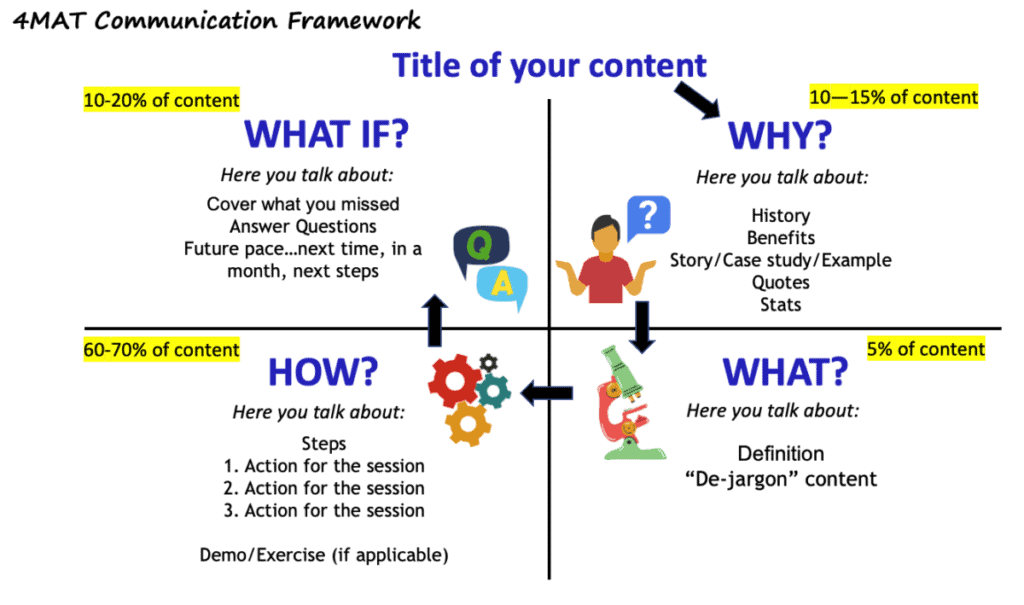Creating and delivering value is the essential purpose of any type of organisation; and, the best way for an organisation to constantly provide that value is to focus on innovation and sustainable growth. This is particularly important in business environments, where moving forward and finding new ways to create value is the key to surviving in the market. To stand out among competitors, the company must learn faster and work smarter, meaning that learning is among the core processes behind every organisational success.
So, understanding (as a business analyst
What is the 4MAT Method?
Developed by Dr. Bernice McCarthy
As a learning model, 4MAT provides tools for understanding the basic differences in how we, as humans, learn and communicate and implements the knowledge of those differences to create an efficient framework for learning and communication.
The 4MAT method incorporates psychology, behavioural, and learning theories and combines them with valuable insights from neurological science. This way, it can provide a holistic perspective of the learning process, ensuring that the information can be easily received and understood by different individuals.
In its essence, 4MAT is a model used for creating more engaged and efficient learning. It helps leaders, educators, and everyone else with a message to convey to deliver information in a more effective and dynamic way.
The main difference between the traditional learning methods and 4MAT is that the former is commonly only focused on the facts and the content of the information itself, while 4MAT goes beyond the mere facts and involves a wider range of questions that serve to elicit a higher level of understanding and involvement.
Why use the 4MAT System?
The 4MAT learning style model stimulates the listeners and information recipients, as well as those delivering the information, to be more involved and motivated, which in turn helps them better understand the value of learning, add their own value to the process, and connect it to personal experience.
Through different approaches to instruction, the 4MAT communication framework can help overcome differences in learning styles, engage diverse groups of listeners, and deliver the information in a way and format that suits everyone.
Mismatches of learning styles among different individuals present quite a challenge, and 4MAT methods help instructors handle these difficulties and achieve the best outcome both in terms of individual development and team performance.
Understanding different learning styles and adjusting communication to suit each of them makes the entire learning process much more enjoyable and allows the acquisition of new skills with much less effort.
Within the organisation, using the 4MAT communication framework can provide multiple benefits. It can strengthen the collaboration between different teams and among team members, which commonly results in much higher productivity. Plus, implementing the 4MAT creates an optimised and enjoyable learning and development environment, something that’s necessary for achieving better results. Perhaps the most important benefit of the 4MAT communication network is that it motivates and inspires everyone to learn and work on themselves.
4MAT Learning Styles
As mentioned above, one of the basic concepts of the 4MAT communication framework is the existence of four different learning styles.
While all learners engage in learning, they commonly lean toward one particular type of learning process, meaning that they may perceive the information in a specific way and have different levels of adopting what they learn.
Below is a brief overview of different learning styles and an explanation of what type of person favours each of them.
Imaginative Learners
The imaginative type of learners sorts out what’s relevant and important in the new information they receive mainly by relying on their gut and intuition.
In most cases, they will take time and think about their actions before taking them, carefully considering their consequences. Initially, they take the information as they see it, before generalising it.
Imaginative types approach the information based on how they feel about it and commonly put in an effort to make the sense of it.
This type of learner is mostly concerned with why something is happening and why is the new information relevant. They prefer learning through communication with other people and tend to model their behaviour to the people they respect.
This makes them dedicated listeners and information recipients, although they may sometimes struggle to go beyond what their initial instinct tells them about the new piece of information. Imaginative learners usually excel in part of the learning that requires innovation and imagination, so the best way to get them involved in the learning process is by providing them with an opportunity to listen and share ideas.
Analytic Learners
Analytic learners assess the relevance of any new information by implementing external data and relying on the previous knowledge they have on the subject. Their learning commonly kicks off with an idea and then reflecting on that idea, analysing it, putting it in a certain context, and allowing it to take new shapes.
So before trying any new approaches and implementing new ideas and concepts, they will reflect and think about things to make the sense of the new information.
In every new learning situation, analytic learners will start with the “what” question and engage with new information on an intellectual level.
They’re more interested in the basic concepts behind the new information than they are in people, but they enjoy debating them and engaging others. If any situation surprises them and introduces new concepts, they’re more than willing to re-examine the initial facts and rethink their approach.
Analytic learners do respect the expertise of other people and are keen on learning what the experts think about certain issues, which makes them a rewarding, but also challenging learning audience.
Common Sense Learners
Common sense learners are probably the most pragmatic type of individual when it comes to how they receive and learn new information.
For them, a new idea is only a starting point that allows them to experiment further and put that concept to the test to see if it’s working or not. Basically, they’re most interested in the way things work, which is why they’re most interested in the “how” behind the new information and ideas.
Pragmatic learners always look to find the usability of new concepts and test them thoroughly to learn about their potential pragmatic implementation.
This makes them valuable members of the teams, as they enjoy solving problems and are commonly the first ones to take on new challenges. However, they may struggle with more abstract concepts because their focus is always on learning how things can work in real-life situations. For this reason, they learn best through hands-on experience.
Dynamic Learners
Dynamic learners are the most active type who likes to dive straight into new experiences without too much concern for theory. They mostly rely on their intuition and start the learning process by engaging with whatever they can see, hear, touch, or feel.
This type of learner likes nothing more than getting straight into the action and is willing to fail repeatedly and test numerous different approaches until they find the one that works.
So, they learn through trial and error, continuously asking “what if,” using this approach as a means of self-discovery until they’re satisfied with the results.
Dynamic learners are valuable to any organisation as they excel in challenging scenarios that call for a lot of flexibility, which is, of course, rather common in the business environment. They’re not afraid to take action, adapt to change, and take necessary risks. Often, they would come to the perfect conclusion in the learning process even without the step of logical justification.
What are the 4 Questions in 4MAT?
The 4MAT learning cycle revolves around four questions, each corresponding with a certain type of learning style described above.

Why?
“Why” is the favourite question of imaginative learners who are focused on the personal benefits of new information, both for themselves and others. They look for personal connection and involvement, trying to figure out why they need to know something.
For example, if they’re learning about a new product, they want to know why is it important and what is its purpose.
What?
“What” corresponds with an analytic learning style and is the favourite question of learners who prefer to listen and think about the new information to discover the key facts and formulate new ideas.
For example, when learning about a new product, they’re most interested in what it actually is, what are its main features, and what the experts think about it.
How?
“How” is what the common sense or pragmatic learners are most interested in. They want to learn about the usability of the new information and love to tinker around and experiment to discover how to apply a certain concept.
For example, if they’re learning about a new product, they want to know how it works and how it can serve the needs of potential users.
What If?
“What if” is the main concern of dynamic learners who like to learn by doing and feeling. They enjoy exploring new possibilities and building their own new adaptations of the initial ideas.
For example, when learning about a new product, they want to find out how it would perform in different circumstances and test it repeatedly by placing it in new and altered situations.
4MAT Communication Framework Template
A 4MAT communication framework template

The 4MAT communication template has instructions of how to use and when to use the template when preparing presentations, talks, emails and workshops.
The 4MAT communication template will help you consider all personality profiles and consequently to communicate effectively.
The 4MAT communication template is in google slide format, MS Power Point format, MIRO format.


